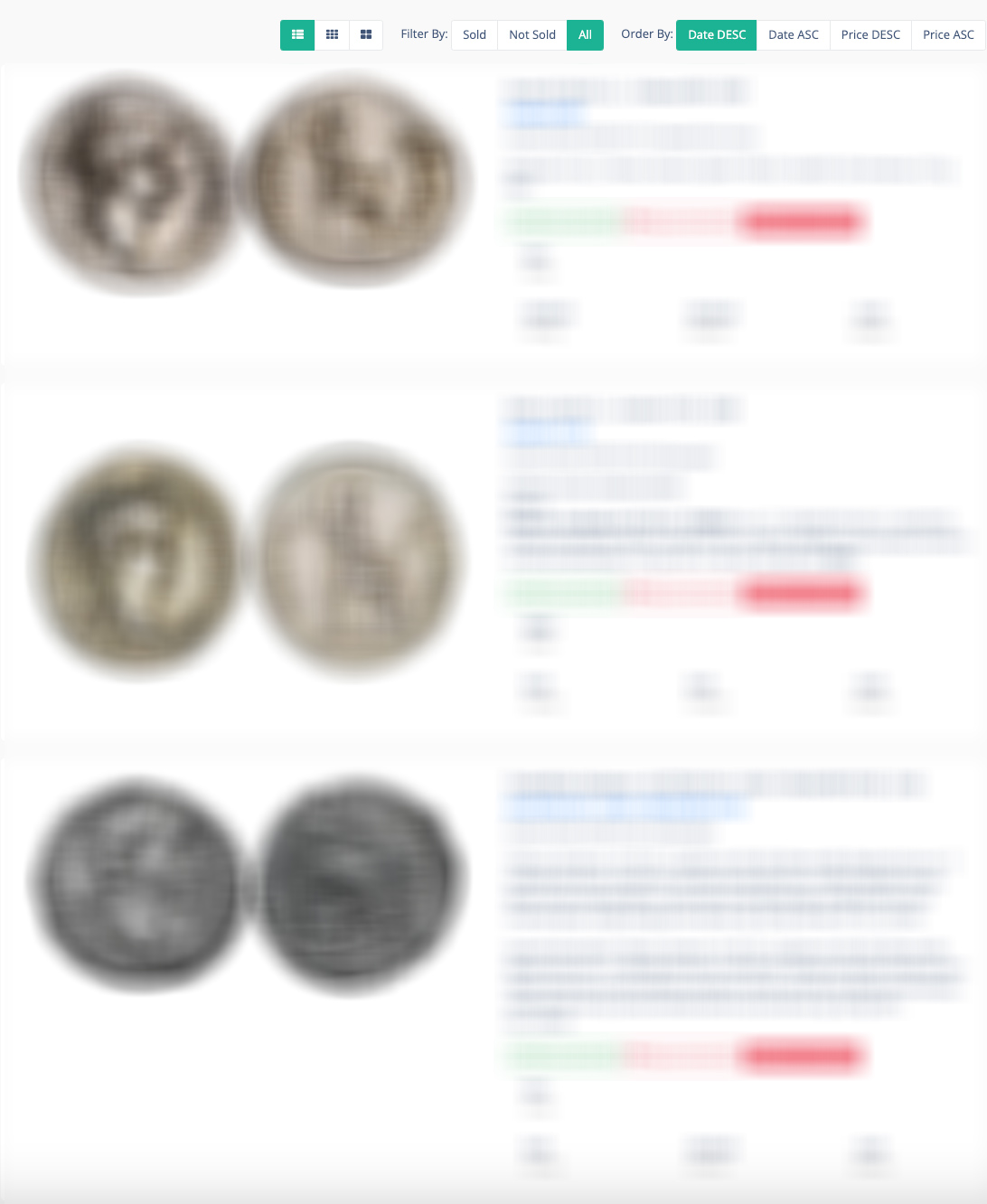Tauler&Fau Subastas - E-Auction 64 – Spanish Coins Vol. VII - 205 Numistats ref: 436139

Felipe V
Authority
8 Reales
Denomination
-
Year
Aureo-Calicó (2019) 1617
Aureo-Calicó (2008) 934
Aureo-Calicó (2008) 935
Aureo-Calicó (2008) 936
Aureo-Calicó (2008) 937
References
Philip V / Felipe V (1700-1746)
Category
Felipe V (1700-1746). 8 reales. 1718. Sevilla. M. (Cal-1617). Ag. 23,46 g. Tres flores de lis en las armas de Borgoña. Escasa. El 31 de octubre de 1716 se decide reducir la ley y el peso de las monedas de plata peninsulares de 11 dineros (91,66%) y 68 reales en marco (3,38g) el real a 10 dineros (83,33%) y un peso de 75 o 77 reales en marco (3,06 y 2,98 g por real), con el objetivo de evitar la salida de metal precioso al extranjero. Este tipo de moneda se la llamó moneda provincial y debería servir para el comercio interior entre los reinos de la península. Con esta ley y peso se acuñó moneda menuda en Cuenca, Madrid, Segovia y Sevilla, pero reales de a 4 y de a 8 solo en 1718 en Sevilla Se mantuvo la ley y el peso antiguo para las amonedaciones en las colonias americanas, dedicadas estas al "comercio mayor" En 1728, se cambia el tipo de las acuñaciones americanas al tipo columnario con un valor de 9 reales y medio provinciales equivalentes a un peso o real de a 8 del comercio mayor. En la misma ley, se ordena que los 4 y 8 reales peninsulares se acuñen para el comercio mayor o internacional con la misma ley y peso que los americanos quedando la moneda provincial solo la plata menor. Las acuñaciones de 4 y 8 reales de Sevilla de 1718 serían las únicas piezas grandes acuñadas con ley 83,33% y peso de 12g y 24g respectivamente. Fué ordenada su retirada en 1726 para evitar confusión.. MBC+/MBC. Est...300,00. /// ENGLISH: Philip V (1700-1746). 8 reales. 1718. Sevilla. M. (Cal-1617). Ag. 23,46 g. Following the end of the war of Spanish Succession in 1713, the new king Philip V had to face the problem that Spanish silver and gold coin were exported abroad and melted, as their finesse and weight were higher than their equivalent in Europe
On 31 October 1716, by Royal Order, the finesse and weight of silver peninsular coins is reduced from 11 dineros (91,66%) and 68 reales in Marco (3,38 g each real) to 10 dineros (83,33%) and 75 or 77 reales in Marco (3,06 g or 2,98 g each real). This new coinage was called provincial coinage, been used only for inland trade, as opposed to coins struck in the American Colonies that maintained the old standard destined to the so called Comercio Mayor or international trade. The provincial coinage was struck in the Royal Mints of Cuenca, Madrid, Segovia and Sevilla in values of 1/2, 1, and 2 reales (minor coinage), but the larger values of 4 and 8 reales were only minted in 1718 in Sevilla
A new Royal Order in 1728, changes the design of the American Colonies coinage to the Columnario type and declares the value of the new coin peso or real de a ocho de Comercio Mayor (international trade) as equivalent to nine and a halve reales provinciales. By the same order, the larger values of peninsular mints, 4 and 8 reales should have the same weight and finesse as the American Columnarios leaving as provincial coinage for internal trade only the minor coins.
Accordingly, the 4 and 8 reales of Sevilla minted in 1718 were the only struck with 83,33% finesse and 12 g and 24 g weight respectively. In 1726 those coins were demonetized and melted to avoid confusion, so they are rarer than similar later emissions. Choice VF/VF. Est...300,00. Description
On 31 October 1716, by Royal Order, the finesse and weight of silver peninsular coins is reduced from 11 dineros (91,66%) and 68 reales in Marco (3,38 g each real) to 10 dineros (83,33%) and 75 or 77 reales in Marco (3,06 g or 2,98 g each real). This new coinage was called provincial coinage, been used only for inland trade, as opposed to coins struck in the American Colonies that maintained the old standard destined to the so called Comercio Mayor or international trade. The provincial coinage was struck in the Royal Mints of Cuenca, Madrid, Segovia and Sevilla in values of 1/2, 1, and 2 reales (minor coinage), but the larger values of 4 and 8 reales were only minted in 1718 in Sevilla
A new Royal Order in 1728, changes the design of the American Colonies coinage to the Columnario type and declares the value of the new coin peso or real de a ocho de Comercio Mayor (international trade) as equivalent to nine and a halve reales provinciales. By the same order, the larger values of peninsular mints, 4 and 8 reales should have the same weight and finesse as the American Columnarios leaving as provincial coinage for internal trade only the minor coins.
Accordingly, the 4 and 8 reales of Sevilla minted in 1718 were the only struck with 83,33% finesse and 12 g and 24 g weight respectively. In 1726 those coins were demonetized and melted to avoid confusion, so they are rarer than similar later emissions. Choice VF/VF. Est...300,00. Description
-
Grade
175 EUR
Starting
300 EUR
Estimate
520 EUR
Realized
Monarquia Española. Felipe V. 8 Reales Aureo-Calicó (2019) 1617 Aureo-Calicó (2008) 934 Aureo-Calicó (2008) 935 Aureo-Calicó (2008) 936 Aureo-Calicó (2008) 937

Felipe V
Authority
8 Reales
Denomination
Sevilla
Mint
-
Year
Aureo-Calicó (2019) 1617
Aureo-Calicó (2008) 934
Aureo-Calicó (2008) 935
Aureo-Calicó (2008) 936
Aureo-Calicó (2008) 937
References
Obverse Legend
Reverse Legend
Obverse Type
Reverse Type
Sold (88%)
Unsold (12%)





